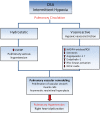Pulmonary hypertension in obstructive sleep apnea: is it clinically significant? A critical analysis of the association and pathophysiology
- PMID: 26064448
- PMCID: PMC4449234
- DOI: 10.1086/679995
Pulmonary hypertension in obstructive sleep apnea: is it clinically significant? A critical analysis of the association and pathophysiology
Abstract
The development of pulmonary hypertension is a poor prognostic sign in patients with obstructive sleep apnea (OSA) and affects both mortality and quality of life. Although pulmonary hypertension in OSA is traditionally viewed as a result of apneas and intermittent hypoxia during sleep, recent studies indicate that neither of these factors correlates very well with pulmonary artery pressure. Human data show that pulmonary hypertension in the setting of OSA is, in large part, due to left heart dysfunction with either preserved or diminished ejection fraction. Longstanding increased left heart filling pressures eventually lead to pulmonary venous hypertension. The combination of hypoxic pulmonary vasoconstriction and pulmonary venous hypertension with abnormal production of mediators will result in vascular cell proliferation and aberrant vascular remodeling leading to pulmonary hypertension. These changes are in many ways similar to those seen in other forms of pulmonary hypertension and suggest shared mechanisms. The majority of patients with OSA do not receive a diagnosis and are undertreated. Appreciating the high prevalence and understanding the mechanisms of pulmonary hypertension in OSA would lead to better recognition and management of the condition.
Keywords: heart failure; hypoxic vasoconstriction; obstructive sleep apnea; pulmonary hypertension.
Figures

References
Publication types
LinkOut - more resources
Full Text Sources
Other Literature Sources

